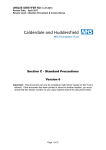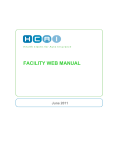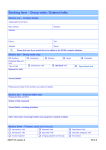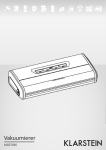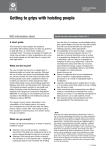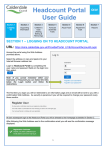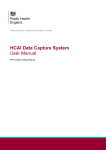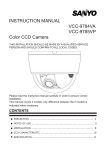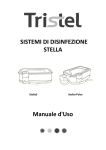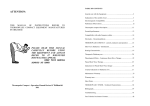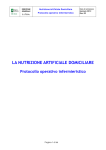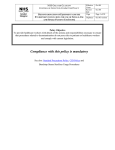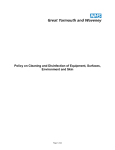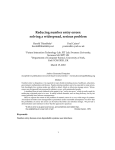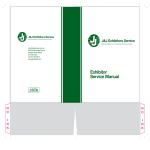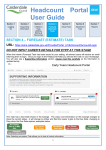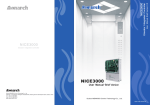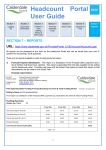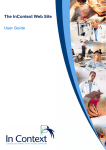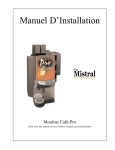Download Universal Infection Control Precautions
Transcript
UNIQUE IDENTIFER NO: C-47-2011 Review Date: April 2013 Review Lead: Infection Prevention & Control Nurse Section C - Standard Precautions Version 4 Important: This document can only be considered valid when viewed on the Trust’s Intranet. If this document has been printed or saved to another location, you must check that the version number on your copy matches that of the document online. Page 1 of 22 UNIQUE IDENTIFER NO: C-47-2011 Review Date: April 2013 Review Lead: Infection Prevention & Control Nurse Document Summary Table Unique Identifier Number Status Version Implementation Date Current/Last Review Dates Next Formal Review Sponsor Author Where available Target audience Ratifying Committees Executive Board C-47-2011 Approved 4 June 2002 February 2006 July 2008 April 2013 Infection Prevention & Control Director Infection Prevention & Control Nurse Trust Intranet All Staff Consultation Committees Committee Name Infection Prevention & Control Committee July 2011 Committee Chair Date Consultant June 2011 Microbiologist / Infection Prevention & Control Doctor Other Stakeholders Consulted All Calderdale and Huddersfield NHS Foundation Trust Infection Prevention and Control Nurses Does this document map to other Regulator requirements? Regulator details Regulator standards/numbers etc Document Version Control Version 4 The document has been redesigned to ensure that all new and revised procedural documents are set out to a Trust wide format and the content of which includes a minimum set of criteria which include: the training requirements for implementation monitoring arrangements for the document Equality Impact of the document In addition, the monitoring arrangements for this document have been included. Page 2 of 22 UNIQUE IDENTIFER NO: C-47-2011 Review Date: April 2013 Review Lead: Infection Prevention & Control Nurse Contents Section 1. 2. 3. 4. 5. 6. 7. 8. 9. 10. 11. Page Document Summary Table Contents Introduction Purpose Definitions Duties (Roles and Responsibilities) Risk Assessment Infection Prevention & Control Precautions a) Hand Hygiene and Hand Care b) Personal Protective Equipment (PPE) c) Gloves d) Plastic Aprons e) Eye Protection f) Masks g) Disposal of Sharps and Accidental Spillages h) Spillages of Blood and Body Fluids Training and Implementation Equality Impact Assessment Monitoring Compliance with this Policy Associated Documents/Further reading References 2 3 4 4 5 5 5 6 6 7 7 8 9 9 9 11 11 11 11 12 12 Appendices 1 2 Tristel Spillages Tristel Fuse COSHH 14 15 Page 3 of 22 UNIQUE IDENTIFER NO: C-47-2011 Review Date: April 2013 Review Lead: Infection Prevention & Control Nurse 1. Introduction Standard precautions are infection prevention and control precautions that should be applied as standard principles by all healthcare staff to the care of all patients at all times. Standard precautions includes universal precautions which regards all blood and body fluids to be potentially infected. Standard precautions also considers the risk of contact with patients’ intact skin and the possibility that the immediate environment may be potentially contaminated with pathogenic micro-organisms. These precautions include the use of personal protective equipment (PPE), the safe handling and disposal of sharps, managing blood and bodily fluids, handling and disposal of waste, and hand hygiene. It is generally recognised that many patients/service users/visitors (and staff) who are not obviously ill may be carrying viruses or other pathogens in their blood/body fluids and pathogens such as MRSA on their skin. Such organisms present an infection hazard to other patients/service users and all healthcare workers who come into contact with them. The implementation of precautions only upon diagnosis of infection may not prevent cross transmission. Therefore, in order to protect patients/service users and staff we must consider all blood and body fluids from all patients i.e. adults, children and neonates and staff to be infected and incorporate measures to minimise the risk of exposure into everyday practices. The DH (2008) states: ‘Effective prevention and control of HCAI has to be embedded into everyday practice and applied consistently by everyone. It is particularly important to have a high awareness of the possibility of HCAI in both patients and healthcare workers to ensure early and rapid diagnosis. This should result in effective treatment and containment of the infection. Effective action relies on an accumulating body of evidence that takes account of current practices.’ Standard precautions apply to both non-uniform and uniform wearing staff and all pertinent guidance issued within this policy and Section H, Hand Hygiene Policy, of the Infection Control Policies & Guidelines Manual, should be followed. Standard precautions are essential components in preventing the transmission of infectious diseases in the healthcare setting. 2. Purpose These guidelines describe the processes and rationales required by all healthcare workers that need to be undertaken to protect themselves and patients/service users against any potential cross transmission of pathogens. Page 4 of 22 UNIQUE IDENTIFER NO: C-47-2011 Review Date: April 2013 Review Lead: Infection Prevention & Control Nurse By adhering to these standard precautions the Healthcare workers (HCWs), patient and service users safety can be enhanced and the risks of acquiring a healthcare associated infection (HCAI) are greatly reduced. 3. Definitions Definition of Body Fluids Any fluid found in, produced by, or excreted from the human body which includes blood, urine, faeces, saliva, tears, breast milk, CSF, semen, vaginal fluid, amniotic fluid, pleural fluid, peritoneal fluid, bile, digestive juices, vomit, pus, other infected discharges and serous fluid. Definition of Contact a) Social Contact Social contact may be defined as a physical contact occurring between a healthcare worker and the patient/service user that might occur in a nonintimate social setting such as a simple handshake. b) Direct Clinical Contact Direct contact is more than would be expected in a social environment and involves close contact with the patient/service user and/or their immediate environment, including physical examinations performed on ward rounds. Direct clinical contact that involves contact with open wounds, invasive devices and other vulnerable sites significantly increases the risk of infection/cross transmission. c) Indirect Contact Indirect contact would include for example the use of chairs – within a waiting room, during a consultation, in the ward environment - seat backs, examination trolleys shared toilet/bathroom facilities (some viable fungus persist in shower/bathroom for long periods). The use of equipment e.g. drip stands, BP machines pulse oximeters also, any contact with the patients environment e.g. bedside tables/lockers. 4. Duties (Roles and responsibilities) The Chief Executive is responsible for ensuring that there are effective infection control arrangements in the Trust. Nursing staff must always comply with Nursing and Midwifery Code of Professional Conduct ‘The Code’, and ‘delegate to those only who are competent for that delegated task’. All other professional staff must abide by their Professional Code together with the Trust’s policies and procedures. Page 5 of 22 UNIQUE IDENTIFER NO: C-47-2011 Review Date: April 2013 Review Lead: Infection Prevention & Control Nurse 5. Risk Assessment All healthcare workers (HCWs) must carry out a risk assessment on the possible exposure to blood and body fluids and the risk of substances containing harmful organisms. HCWs should always implement infection prevention and control precautions to prevent transmission of these organisms and minimise the spread of infection. HCWs with direct clinical and environmental contact must also assess the risk of contamination to their own clothing/uniform from microorganisms and implement infection prevention and control precautions to prevent further spread. 6. Infection Prevention and Control Precautions a) Hand Hygiene and Hand Care Hand decontamination is the single most important measure in infection control. Effective hand decontamination can significantly reduce infection rates (WHO 2009). Hand hygiene should be undertaken immediately before and directly after any patient contact or procedures including those defined as ‘social contact’. Hands should be free from organic material or dirt if using an alcohol gel, and the solution must have evaporated and hands allowed to dry. Hands can also be decontaminated using soap and water and dried thoroughly. Hands should be decontaminated before and after all procedures and before and after removing gloves and/or any other PPE. Also, hands should be washed immediately if contaminated with blood and/or body fluids using soap and water and then dried thoroughly. A suitable hand moisturiser should be available for use in wards and departments, and used as required. Any staff with chronic skin lesions or infected skin conditions to hands or forearms must seek advice from the Occupational Health Department, as soon as possible, before commencing work. Any existing cuts/lesions or any other breaks in the skin should be covered with a waterproof dressing and replaced when necessary (see below). Before a shift of clinical work begins, all wrist and ideally hand jewellery should be removed’ (epic2 p.S18). This will facilitate effective hand hygiene. All healthcare staff who carry out social or direct clinical contact with patients/service users and /or the healthcare environment should adhere to Section H Hand Hygiene Policy of the Infection Control Policies and Guidelines Manual. Cover cuts and abrasions with waterproof dressings. Keep nails short, clean and varnish free. Not wear false nails. Not wear wrist jewellery. Page 6 of 22 UNIQUE IDENTIFER NO: C-47-2011 Review Date: April 2013 Review Lead: Infection Prevention & Control Nurse Not wear rings, the only exception being a plain wedding band. Be ‘Bare Below the Elbow’. All HCWs, including non-uniformed staff who carry out direct clinical contact which involves contact with open wounds, invasive devices or other vulnerable sites must adhere to the above and also: Remove outer clothing i.e. white coat/jacket. Roll sleeves up above the elbow. Put on a plastic disposable apron, and any other appropriate PPE If wearing a tie tuck this under the plastic apron. The next sections of the Policy discuss the use of protective clothing. This applies to all uniformed and non-uniformed HCWs/Professionals who are undertaking any patient/service user contact. Further information on dress code can be found under General Policies for the Principles of Uniform and Non Uniform Staff. b) Personal Protective Equipment (PPE) PPE should be selected on the basis of an assessment of the risk of transmission of micro-organisms to the patient and the risk of contamination of healthcare practitioners’ clothing and skin by blood, body fluids, secretions, excretions. This can be by direct or indirect contact with the patient/service user and/or their immediate environment. All PPE together with any waste produced must be disposed of into the appropriate waste stream. For further information on the disposal of PPE please refer to the Waste Disposal Policy available on the Trust’s intranet. Hand hygiene must be performed prior to and following removal of all PPE. Personal Protective Equipment: Risk Assessment Assess Risk of Task No contact with blood/body fluids Contact with blood/body fluids low risk of splashing Contact with blood/body fluids high risk of splashing Contact with patients and/or equipment irrespective of un/known infectious microorganism with potential risk of contamination to clothing No gloves/ aprons Gloves/ aprons Gloves, aprons, eye/ mouth protection Disposable plastic aprons Page 7 of 22 UNIQUE IDENTIFER NO: C-47-2011 Review Date: April 2013 Review Lead: Infection Prevention & Control Nurse c) Gloves Gloves must be worn for: invasive procedures contact with sterile sites contact with non-intact or skin-mucous membranes all activities that have been assessed as carrying a risk of exposure, or involve direct contact with, blood, body fluids, secretions and excretions handling contaminated instruments when in contact with a patient or their environment who is known or highly suspected to have Clostridium Difficile Hands should always be decontaminated before donning gloves and after their removal. Gloves are not a substitute for hand washing, they should be put on immediately before the task is to be performed. Therefore, if items are collected from a cupboard whilst wearing any PPE (e.g. dressings) that PPE must be removed and discarded. Fresh PPE to be worn immediately prior to that patient contact episode. Gloves should be worn as single-use items. Remove gloves immediately after completing the task they were required for. Change gloves between caring for different patients or between different care/treatment activities for the same patient. If known or highly suspected infection gloves must be disposed of through the orange waste stream. Sterile gloves (low protein) should be worn for all operative and invasive procedures that require an aseptic technique/ANTT. Non-sterile gloves (low protein) should be worn for non-sterile procedures when contact with blood or body fluids is possible. Non-sterile gloves can be worn when performing an aseptic nontouch technique – see Aseptic Policy Section G. Special gloves are required for use with certain chemicals. Seek advice from the manufacturer of the Chemical and comply with COSHH. Staff with a known or suspected latex allergy must not use latex gloves and must contact Occupational Health as soon as possible for advice. Latex gloves must not be used if the patient has, or is suspected of having, a latex allergy. Alternative gloves can be provided for those with allergies. Page 8 of 22 UNIQUE IDENTIFER NO: C-47-2011 Review Date: April 2013 Review Lead: Infection Prevention & Control Nurse d) Plastic Aprons Disposable plastic aprons must be worn when there is a risk that clothing or uniform may become exposed to contamination from the environment, blood, body fluids, secretions and excretions with the exception of sweat. Full body fluid repellent gowns should be worn where there is a risk of extensive splashing of blood, body fluids, secretions and excretions onto the skin of staff. Uniforms/clothing that becomes contaminated must be laundered at the earliest opportunity. Please note only the Trust’s laundry should be used for staff uniforms irrespective of contamination. Disposable plastic aprons are single-use items and must only be used for one procedure or episode of patient care i.e. bed making/handling linen. During procedures where protection from splashes is required and plastic aprons cannot be worn (e.g. X-ray) alternative clothing must be water resistant and cleanable. e) Eye Protection Eye protection must be available in all areas for use when there is a risk of blood, body fluids, secretions and excretions splashing into the eyes. These should be decontaminated after use and stored clean. If single-use then dispose of immediately into the appropriate waste stream. f) Masks Surgical face masks should be worn when there is a risk of contamination of the mouth and nose by splashes of blood, body fluids, secretions and excretions or from an aerosol that may be created and inhaled (e.g. bone sawing, air power tools, open airway management or some respiratory diseases). Respirators (FFP3 masks) may be recommended with certain respiratory diseases e.g. multi-drug resistant TB and procedures (e.g. bronchoscopy). A limited emergency supply is available from the Infection Control cupboards located outside Old Ward 10, Calderdale Royal Hospital (key held by site co-ordinator and Infection Prevention and Control Nurses) and outside Pathology at Huddersfield Royal Infirmary (key from security staff on the front desk). For further information on the usage of masks please refer to Section S Tuberculosis of the Infection Control Policies and Guidelines Manual. If a patient is suspected to have or is confirmed to have flu (seasonal or pandemic) a surgical mask is sufficient to wear upon entering the patients/service users side room and for performing most medical/nursing Page 9 of 22 UNIQUE IDENTIFER NO: C-47-2011 Review Date: April 2013 Review Lead: Infection Prevention & Control Nurse tasks. If however, aerosol generating procedures are to be performed (e.g. bronchoscopy, CPR) a FFP3 mask is advised. The ordering and stock levels of the FFP3 masks are the sole responsibility of the ward/department. All PPE together with any waste produced must be disposed of into the appropriate waste stream. Hands should always be decontaminated before and after removal of any PPE. g) Disposal of Sharps Sharps that are handled incorrectly and not disposed of adequately are extremely dangerous. It is the responsibility of the user to dispose of their sharps device safely, immediately after use. This means the sharps container should be portable enough to take to the site of the intended procedure, and be designed specifically to allow sharp instruments and needles to be disposed of safely and easily at the point of use. For further advice see Section M Sharps Policy of the Infection Control Policies and Guidelines Manual. Accidental Spillages Protective clothing must be worn prior to dealing with any spillage of blood and/or body fluids. Ensure adequate ventilation prior to using disinfection solutions or granules. Spillage from domestic waste (clear bag waste) Clean up with dustpan and brush or mop and place in fresh clear bag for disposal. Spillage from offensive waste bags/clinical waste bags (tiger stripe bags/orange bags), sharps containers or laboratory waste bags – Inform the appropriate departmental manager immediately. A full risk assessment must be made prior to cleaning up spillages from the Orange waste bags as masks may need to be worn. Follow guidelines below and complete an incident report form: Clinical Waste Spillage – wearing disposable apron and gloves together with any other appropriate PPE (having made a thorough risk assessment) carefully place the waste into another same type bag. Clean the contaminated area with paper towels followed by a chlorine releasing agent e.g. Tristel Fuse solution. Tristel Fuse is sufficient to use where there is visible blood. Place protective clothing and all paper towels into same type bag, seal and dispose of immediately. Sharps Container Spillage – Always wear a disposable apron and gloves. For broken or partially open containers place into a larger sharps bin where possible. Any spilled medicine and all items used Page 10 of 22 UNIQUE IDENTIFER NO: C-47-2011 Review Date: April 2013 Review Lead: Infection Prevention & Control Nurse in the cleaning process e.g. gloves, paper towels/clothes/mop heads etc. must be placed into the correct stream/bin. Please refer to the Medicine Code section 17 using this link: http://nww.cht.nhs.uk/index.php?id=4848&cat=3. The section reads: 12. Pharmaceutical Spillage Hazardous spillage - For full information on cytotoxic spillage process and kit please refer to: http://intranet.cht.nhs.uk/formulary/WebFormulary_Files/pdf,_doc_files_etc /MMC/086_Cytotoxic_Drug_Spillage.pdf If a dust pan and brush is used the dust pan will require a thorough clean using Tristel. The brush may be contaminated with glass particles/chemicals and would therefore require disposing of in the appropriate waste stream e.g. Pharmaceutical Liquid bin. Otherwise decontamination using Tristel would be required. Spillages onto carpeted areas – wearing disposable apron and gloves soak up the excess with disposable cloth and clean area with detergent and hot water. This may need repeating several times to remove all spillage. The carpet should be steam cleaned at the first available opportunity. h) Spillages of Blood and Body Fluids Protective clothing must be worn prior to dealing with any spillage of blood and/or body fluids. Procedure for spillages of blood or blood stained body fluids: Cover spillage with disposable paper towels. In the event of large spillages soak up the majority with paper towels and place into the appropriate waste stream taking care not to cause any spillages then apply further paper towels to area. Make up chlorine releasing agent e.g. Tristel Fuse. Impregnate paper towels or disposable ‘j’ cloths with the Tristel and clean the area thoroughly before discarding paper towels/’j’ cloths and worn PPE into appropriate waste stream. Allow to dry thoroughly Decontaminate hands Spillages of faeces, vomit and urine – should be removed with paper towels and the area cleaned with a chlorine releasing agent e.g. Tristel Page 11 of 22 UNIQUE IDENTIFER NO: C-47-2011 Review Date: April 2013 Review Lead: Infection Prevention & Control Nurse Fuse, using paper towels, discarding all waste and protective clothing into the appropriate waste stream. Any floor surface that has been cleaned and remains wet must have the appropriate Yellow warning sign in place. 7. Training and Implementation Training will be carried out to all Trust staff by the Infection Prevention and Control Team through Induction Training, Back to Basics training sessions as well as targeted training sessions to key personnel/ areas. This includes Link Infection Prevention and Control Practitioners in departments and wards across the trust who will then cascade the information to colleagues within their area/departments. 8. Equality Impact Statement Calderdale and Huddersfield NHS Foundation Trust aims to design and implement services, policies and measures that meet the diverse needs of our service, population and workforce, ensuring that none are placed at a disadvantage over others. We therefore aim to ensure that in both employment and services no individual is discriminated against by reason of their age, race, faith, culture, gender, sexuality, marital status or disability. 9. Monitoring Compliance with this Procedural Document Monitoring compliance with the policy will be monitored through clinical audit as an ongoing process. 10. Associated Documents/Further Reading Calderdale and Huddersfield NHS Foundation Trust Swine Flu Ward Managers Resource pack. (2009) Clean Safe Care revised website: www.clean-safe-care.nhs.uk Epic2 National Evidence-Based Guidelines for Preventing HealthcareAssociated Infections in NHS Hospitals in England. Journal of Hospital Infection (2007) 65 (Supplement). General Policies: Principles for Uniform and Non Uniform Staff Waste Disposal Policy Medicine Code: Medicine Code 17 – Medicines no longer requiredReturn or disposal Infection Control Policies & Guidelines: Page 12 of 22 UNIQUE IDENTIFER NO: C-47-2011 Review Date: April 2013 Review Lead: Infection Prevention & Control Nurse Section G Aseptic Technique Policy Section H Hand Hygiene Section M Management of Clinical Sharps Injuries and Exposure to Blood and High Risk Body Fluids Section P Care of the Deceased Section S Tuberculosis Section T Multi-Resistant Organism Policy NICE Clinical Guideline 2 (2003) Infection Control Prevention of Healthcare Associated Infections in Primary and Community Care. NICE, London. Wilson J (2006), Infection Control in Clinical Practice (3rd Edition), Bailliere Tindall, London 11. References DH (2008) The Health and Social Care Act, Code of practice for the NHS on the prevention and control of healthcare associated infections and related guidance. epic2: National Evidence-Based Guidelines for Preventing HealthcareAssociated Infections in NHS Hospitals in England. Journal of Hospital Infection (2007) 65 (Supplement), p S18. Hawker J, Begg N, Blair I, Reintjes R, Weinberg J. (2005) Communicable Disease Control Handbook (2nd edition), Blackwell, London Needlestick Injuries Document available at: http://www.nhsemployers.org/Aboutus/Publications/Documents/Needlestic k%20injuryPDF NPSA, Based on ‘My 5 moments for Hand Hygiene’. Copyright WHO 2009. NMC, (2008) The Code. Professional Code of Conduct for Nurses and Midwives. Nursing and Midwifery Council, London RCN (2009) Infection Prevention and Control: Minimum Standards, RCN, London. Peate I (2008) Body fluids part 1: infection control, British Journal of Healthcare Assistants, (2008) Vol 02 No 01 The Epic Project: Developing National Evidence – based Guidelines for preventing Healthcare associated Infections. Phase 1: Guidelines for Preventing Hospital Acquired Infections. Journal of Hospital Infection (2001) 47 (Supplement). Page 13 of 22 UNIQUE IDENTIFER NO: C-47-2011 Review Date: April 2013 Review Lead: Infection Prevention & Control Nurse Thomas V (ed) (2011) Fundamental Aspects of Infection Prevention and Control, Quay Books, London. Chapter 7. UK Health Departments (1998) Guidance for Clinical Health Care Workers: Protection against infection with blood-borne viruses. Recommendations of the Expert Advisory Group on AIDS and the Advisory Group on Hepatitis. London, DH. WHO (2009) Guidelines on Hand Hygiene in Health Care. First Global Patient Safety Challenge Clean Care is Safer Care. Chapter 7 Page 14 of 22 UNIQUE IDENTIFER NO: C-47-2011 Review Date: April 2013 Review Lead: Infection Prevention & Control Nurse Appendix 1 Management of blood / bodily fluid spillages Put on PPE (gloves and apron) Using absorbent material (Conti wipe or paper towel), soak up the spill, removing as much as physically possible. Discard the soiled wipes to clinical waste bag. Apply Tristel Fuse or Jet to the contaminated surface and leave to dry. Do not rinse. Discard PPE and used cloths to clinical waste bag. Wash hands. Page 15 of 22 UNIQUE IDENTIFER NO: C-47-2011 Review Date: April 2013 Review Lead: Infection Prevention & Control Nurse Tristel Fuse for Surfaces Appendix 2 Working Solution Safety Data Sheet ______________________________________________________________ Product Name: Tristel Fuse for Surfaces – Working Solution Revision Number FUS/SUR/SDS/006 Publication Date 19.02.08 Product Code: FUS/SUR Type of product: High-level disinfecting and sporicidal solution for surfaces Manufacturer: Tristel Solutions Limited Lynx Business Park Fordham Road Snailwell Cambs CB8 7NY Telephone Number: +44 (0) 1638 721500 Fax Number: +44 (0) 1638 721911 Emergency Number: +44 (0) 7798 805692 (out of business hours) Chemical type: Mild Oxidising Solution _______________________________________________________________________________________________ Composition: ______________________________________________________________________ Ingredients CAS No EINECS No Wt/Vol % Symbol Chlorine dioxide in aqueous solution Surfactant: Decamine Oxide Water 10049-04-4 233-162-8 0.01-0.0125 ClO 0.002 HO Hazards identification: Chlorine dioxide generator 2605-79-0 2 (OES of 0.3ppm short term; 0.1ppm long term) First aid measures: Inhalation: Non-toxic Eye contact: Rinse eyes with water Skin contact: Wash affected area with water Ingestion: Do not induce vomiting. Give water to drink Seek medical advice where necessary Fire fighting measures: Non flammable Accidental release measures: Environmental precautions: Environmental precautions required but product is biodegradable under OECD conditions operational 6/1995 Clean up method: Flush to drain with water or soak up onto inert material and dispose of with clinical waste Clothing for disposal: Wear appropriate gloves and apron This document conforms with Regulation 6 of the Chemicals (Hazard Information and Packaging Supply) Regulations 2002 (CHIP3) _______________________________________________________________________________________________ Tristel User Manual/Section 4/Master File/January 2008/Revision Number 005 2 Page 16 of 22 UNIQUE IDENTIFER NO: C-47-2011 Review Date: April 2013 Review Lead: Infection Prevention & Control Nurse Tristel Fuse for Surfaces Working Solution Safety Data Sheet ______________________________________________________________ Handling and storage: Revision Number FUS/SUR/SDS/006 Publication Date 19.02.08 Handling guidelines: Safe handling in accordance with label instructions Not to be mixed with other chemicals Keep from children Storage guidelines: Store out of direct sunlight Single-Use solution Exposure controls/personal protection: Personal protection: Avoid eye contact and prolonged skin contact Gloves and apron recommended Skin contact: Low risk No known hazard Eye contact: Low risk No known hazard Inhalation: Low risk Ingestion: Low risk, substantial ingestion may cause discomfort to mouth and digestive tissues Physical and chemical properties: Physical state: Liquid Appearance and odour: Light yellow with mild odour Evaporation rate: As water Boiling point: 100 degrees centigrade Freezing point: As water % Volatile (by weight): Not known Solubility in water (20°C): Soluble pH: 5.5 approximately Specific gravity 1.005 @ 20°C This document conforms with Regulation 6 of the Chemicals (Hazard Information and Packaging Supply) Regulations 2002 (CHIP3) _______________________________________________________________________________________________ Tristel User Manual/Section 4/Master File/January 2008/Revision Number 005 3 Page 17 of 22 UNIQUE IDENTIFER NO: C-47-2011 Review Date: April 2013 Review Lead: Infection Prevention & Control Nurse Tristel Fuse for Surfaces Working Solution Safety Data Sheet ______________________________________________________________ Revision Number FUS/SUR/SDS/006 Publication Date 19.02.08 Stability and reactivity: Decomposes to simple salt solution Hazardous decomposition products: None under normal use Chlorine donors and oxygen produced if heated Toxicological information: LD50 (oral, rat) >5,000 mg/kg Irritation to skin (rabbit) Negative Irritation to eyes (rabbit) Negative Sensitisation (guinea pig) Negative Ecological information: Presents no known hazards to the environment Disposal considerations: Packaging: Can be disposed of as normal waste in accordance with local authority regulations Contaminated packaging: May be disposed of safely under normal conditions in accordance with local authority regulations Product: Solution to be disposed of in accordance with spillage instructions as explained in accidental release measures Transport information: No special conditions apply, non hazardous Regulatory information: Not a licensed medicine Other information: Safety phrases: (2) Keep out of reach of children (50) Do not mix with other chemicals This document conforms with Regulation 6 of the Chemicals (Hazard Information and Packaging Supply) Regulations (CHIP3) Tristel User Manual/Section 4/Master File/January 2008/Revision Number 005 4 Page 18 of 22 UNIQUE IDENTIFER NO: C-47-2011 Review Date: April 2013 Review Lead: Infection Prevention & Control Nurse Tristel Fuse for Surfaces Activator & Base Safety Data Sheet Revision Number FUS/SUR/SDS/006 Publication Date 19.02.08 Product Name: Tristel Fuse for Surfaces – Activator Solution Product Name: Chemical Type: Chemical Type: Sodium salt solution Tristel Fuse for Surfaces – Base Solution Organic acid blend Composition/information on ingredients: Composition/information on ingredients: Major ingredients: 2.1% Sodium chlorite solution in Major ingredients: Hazards Identification: No specific hazards de-mineralised water Contact with acids liberates chlorine dioxide First-aid measures: 5% solution of citric acid, with preservatives and 20% surfactant (Decamine Oxide) in de-mineralised water Hazards No specific hazards Identification: First-aid measures: Inhalation: Non-toxic Inhalation: Non-toxic Eye contact: Rinse eyes with water Eye contact: Rinse eyes with water Skin contact: Wash affected area with water Skin contact: Wash affected area with water Ingestion: Do not induce vomiting give milk or water to drink Ingestion: Do not induce vomiting give milk or water to drink Seek medical advice where necessary Seek medical advice where necessary Fire fighting measures: Fire fighting measures: Non flammable Non flammable Accidental release measures: Accidental release measures: Environmental Precautions: Environmental precautions required but product is biodegradable under OECD conditions operational 6/1995 Environmental Precautions: Clean up method: Flush to drain with water or soak up onto inert material and dispose of with clinical waste Clean up method: Flush to drain with water or soak up onto inert material and dispose of with clinical waste Clothing for disposal: Wear appropriate gloves and apron Clothing for disposal: Environmental precautions required but product is biodegradable under OECD conditions operational 6/1995 Wear appropriate gloves and apron This document conforms with Regulation 6 of the Chemicals (Hazard Information and Packaging Supply) Regulations 2002 (CHIP3) ____________________________________________________________________________________________________________ Tristel User Manual/Section 4/Master File/January 2008/Revision Number 005 5 Page 19 of 22 UNIQUE IDENTIFER NO: C-47-2011 Review Date: April 2013 Review Lead: Infection Prevention & Control Nurse Tristel Fuse for Surfaces Activator & Base Safety Data Sheet Revision Number FUS/SUR/SDS/006 Publication Date 19.02.08 Product Name: Tristel Fuse for Surfaces – Activator Solution Product Name: Handling and storage: Handling and storage: Handling guidelines: Handling guidelines: Storage guidelines: Safe handling in accordance with label instructions Tristel Fuse for Surfaces – Base Solution Safe handling in accordance with label instructions Not to be mixed with other chemicals Not to be mixed with other chemicals Keep from children Keep from children Store out of direct sunlight Storage guidelines: Shelf life – two years – see product for expiry date Store out of direct sunlight Shelf life – two years – see product for expiry date Exposure controls/personal protection: Exposure controls/personal protection: Personal protection: Personal protection: Avoid eye contact and prolonged skin contact Gloves and apron Recommended Skin contact: Low risk Gloves and apron recommended Skin contact: No known hazard Eye contact: Low risk Avoid eye contact and prolonged skin contact Low risk No known hazard Eye contact: No known hazard Low risk No known hazard Inhalation: Low risk Inhalation: Low risk Ingestion: Low risk, substantial ingestion may cause discomfort to mouth and digestive tissues Ingestion: Low risk, substantial ingestion may cause discomfort to mouth and digestive tissues Physical and chemical Properties: Physical and chemical Properties: Physical state: Liquid Physical state: Liquid Appearance and odour: Clear colourless solution, no odour Appearance and odour: Pale green, mild odour Evaporation rate: As water Evaporation rate: As water Boiling point: 100 degrees centigrade Boiling point: 100 degrees centigrade This document conforms with Regulation 6 of the Chemicals (Hazard Information and Packaging Supply) Regulations 2002 (CHIP2) _______________________________________________________________________________________________ Tristel User Manual/Section 4/Master File/January 2008/Revision Number 005 6 Page 20 of 22 UNIQUE IDENTIFER NO: C-47-2011 Review Date: April 2013 Review Lead: Infection Prevention & Control Nurse Tristel Fuse for Surfaces Activator & Base Safety Data Sheet ______________________________________________________________________ Revision Number FUS/SUR/SDS/006 Publication Date 19.02.08 Product Name: Tristel Fuse for Surfaces – Activator Solution Product Name: Tristel Fuse for Surfaces – Base Solution Physical and chemical Properties continued: Physical and chemical Properties continued: Freezing point: As water Freezing point: As water % Volatile (by weight): Not known % Volatile (by weight): Not known Solubility in water Soluble (20C) Solubility in water Soluble (20C) pH: pH: 11.5 - 13 approximately 1.5 – 3.5 approximately Specific gravity: 1.025 @ 20C Specific gravity: 1.020 @ 20C Stability and reactivity: Stability and reactivity: No decomposition if stored and used as directed No decomposition if stored and used as directed Hazardous decomposition products: Hazardous decomposition products: None under normal use None under normal use Chlorine donors and oxygen produced if heated Not compatible with alkaline substance and chlorine donors Toxicological information: Toxicological information: Animal studies: No known risks to skin Exposure Acute oral LD50: >4000 mg/kg Human studies: No known risks to skin exposure Animal studies: No known risks to skin exposure Human studies: No known risks to skin Exposure Ecological information: Ecological information: No known adverse effects from normal use No known adverse effects from normal use Disposal considerations: Disposal considerations: Packaging: Can be disposed of as normal waste in accordance with local authority regulations Packaging: Can be disposed of as normal waste in accordance with local authority regulations Contaminated packaging: May be disposed of safely under normal conditions in accordance with local authority regulations Contaminated packaging: May be disposed of safely under normal conditions in accordance with local authority regulations This document conforms with Regulation 6 of the Chemicals (Hazard Information and Packaging Supply) Regulations _________________________________________________________________________________________________2002 (CHIP3) Tristel User Manual/Section 4/Master File/January 2008/Revision Number 005 7 Page 21 of 22 UNIQUE IDENTIFER NO: C-47-2011 Review Date: April 2013 Review Lead: Infection Prevention & Control Nurse Tristel Fuse for Surfaces Activator & Base Safety Data Sheet ______________________________________________________________ Revision Number FUS/SUR/SDS/006 Publication Date 19.02.08 Product Name: Tristel Fuse for Surfaces – Activator Solution Product Name: Disposal considerations continued: Disposal considerations continued: Product: Product: Solution to be disposed of in accordance with spillage instructions as explained in accidental release meansures Solution to be disposed of in accordance with spillage instructions as explained in accidental release measures Tristel Fuse for Surfaces – Base Solution Transport information: Transport information: No special conditions apply, non hazardous No special conditions apply, non hazardous Regulatory information: Regulatory information: Not a licensed medicine Not a licensed medicine Other information: Other information: Safety phrases Safety phrases (2) (2) Keep out of reach of children Keep out of reach of children (24/25) Avoid contact with skin and eyes (24/25) Avoid contact with skin and eyes (50) Do not mix with other chemicall Do not mix with other chemicals This document conforms with Regulation 6 of the Chemicals (Hazard Information and Packaging Supply) Regulations 2002 (CHIP3) _______________________________________________________________________________________________ Tristel User Manual/Section 4/Master File/January 2008/Revision Number 005 7 Page 22 of 22























